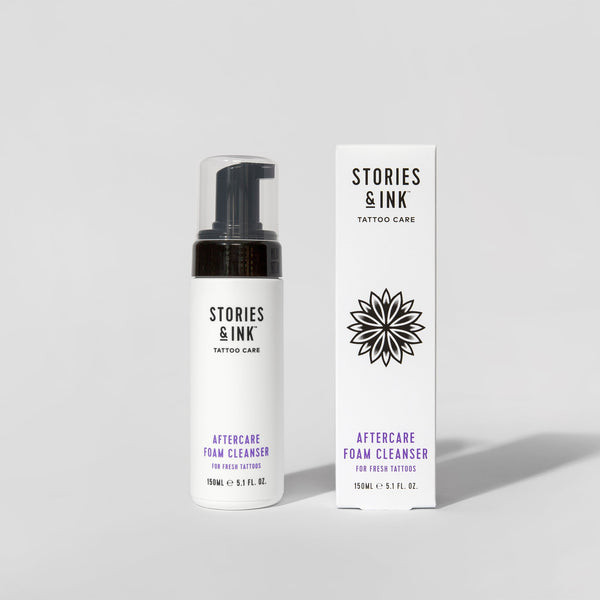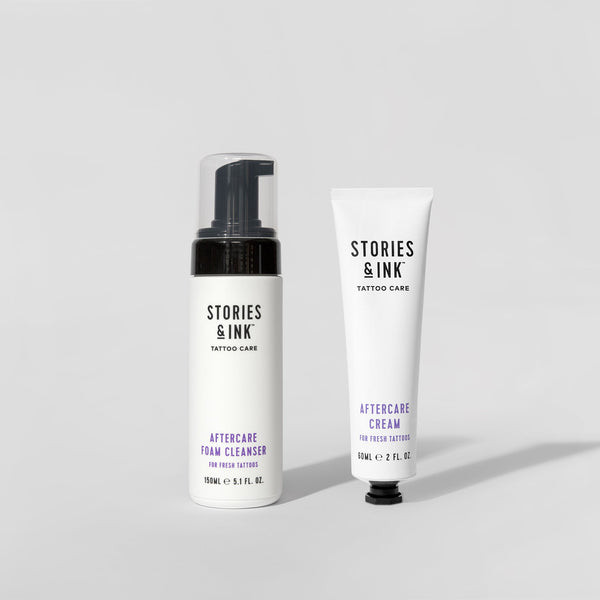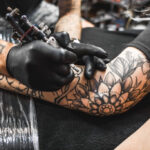Getting a new tattoo is an exciting experience. You’ve chosen your design, endured the tattooing process, and now you’re the proud owner of fresh ink. But along with the excitement comes responsibility, especially when it comes to aftercare. One of the most common questions new tattoo recipients have is: “How soon, and how, can I shower with my new tattoo?”
It’s a valid concern. You want to keep your new artwork clean to prevent infection and promote healing, but you also don’t want to damage it in the process. Don’t worry, showering with a new tattoo is not only possible, but also a crucial part of tattoo aftercare. This comprehensive guide will walk you through everything you need to know about showering safely and effectively with a new tattoo, ensuring a smooth and happy healing journey for both you and your ink.
How Long to Wait Before Showering After a New Tattoo?
Patience is key when it comes to showering after getting inked. The general recommendation is to wait at least 24 hours before exposing your new tattoo to water in the shower. This waiting period is crucial because it allows the initial healing process to begin. Think of your new tattoo as an open wound (because, technically, it is!). Allowing it to air dry for the first day helps the skin start to close and reduces the risk of bacterial infection.
During this initial 24-hour period, your tattoo will be bandaged, usually with a sterile bandage or plastic wrap applied by your tattoo artist. Leave this bandage on for the recommended time your artist advises, typically a minimum of a few hours. After removing the initial bandage, you might see some oozing of ink, blood, and plasma – this is perfectly normal. Gently clean the area as instructed by your tattoo artist, usually with a mild antibacterial soap and lukewarm water, and pat it dry. Avoid immersing it in water until at least 24 hours have passed.
Following your tattoo artist’s specific instructions is paramount. They are the experts who know the size, style, and location of your tattoo and can provide tailored advice. They might recommend waiting longer than 24 hours in certain cases, depending on these factors. Always prioritize their guidance for the best healing outcome.
Step-by-Step Guide: How to Shower with a New Tattoo
Once the 24-hour waiting period is over, or as advised by your tattoo artist, you can shower. However, showering with a new tattoo requires a gentle and mindful approach. Here’s a step-by-step guide to ensure you clean yourself without compromising your new ink:
Keep Showers Short and Sweet
Prolonged exposure to water is not beneficial for a healing tattoo. Aim for short showers, ideally between 5 to 10 minutes. This minimizes the time your tattoo is in contact with water, reducing the risk of overhydration and potential damage to the healing skin. Think of it as a quick rinse to get clean, rather than a long soak.
Lukewarm Water is Your Best Friend
Avoid hot water when showering with a new tattoo. Hot water can open up your pores, increasing the risk of ink bleeding and potentially causing excessive swelling and redness in the tattooed area. Stick to lukewarm water instead. Lukewarm water is gentle on the skin, cleanses effectively, and is less likely to cause irritation or damage to your fresh tattoo. It helps maintain a stable environment for healing.
Gentle Cleansing is Key
When it comes to soap, less is more. Harsh soaps, heavily fragranced body washes, and abrasive scrubs are definite no-gos for new tattoos. These products can irritate the sensitive skin, dry it out excessively, and even cause allergic reactions, hindering the healing process and potentially affecting the tattoo’s appearance.
Opt for a mild, fragrance-free, and antibacterial soap. Many tattoo artists recommend specific tattoo aftercare washes, or gentle, unscented options like baby soap or castile soap. When washing, use your clean hands rather than a washcloth or loofah. Washcloths can harbor bacteria and be too abrasive for a new tattoo. Gently lather the soap in your hands and lightly cleanse the tattooed area. Avoid excessive rubbing or scrubbing. Focus on gently removing any surface debris or bacteria without disrupting the healing skin.
Pat, Don’t Rub, to Dry
After showering, drying your tattoo properly is as important as the shower itself. Avoid rubbing your tattoo with a towel. Rubbing can be too harsh on the delicate healing skin and may dislodge scabs prematurely, leading to ink loss or scarring.
Instead, use a clean, soft towel and pat the tattooed area dry. Gently dab the towel over the tattoo to absorb the water. Ensure the tattoo is completely dry before applying any aftercare ointment or lotion, as trapping moisture can also lead to complications. Air drying for a few minutes after patting can also be beneficial to ensure complete dryness.
 Stories & Ink Aftercare Foam Cleanser for gentle tattoo cleaning
Stories & Ink Aftercare Foam Cleanser for gentle tattoo cleaning
Extra Protection: Using Waterproof Bandages for Showering with a New Tattoo
Sometimes, life demands a bit more from our hygiene routines, even with a new tattoo. While short, lukewarm showers are ideal, there might be situations where you need to shower sooner, more frequently, or for longer periods. This is where waterproof bandages become incredibly helpful for protecting your new tattoo.
Waterproof bandages act as a barrier, shielding your tattoo from direct water exposure during your shower. This is especially useful if you:
- Need to shower sooner than 24 hours: In situations where you absolutely must shower before the recommended 24-hour mark, a waterproof bandage can offer a degree of protection. However, remember that waiting the full 24 hours is always preferable.
- Prefer longer or more frequent showers: If you are accustomed to longer showers or shower more than once a day, using a waterproof bandage can allow you to maintain your routine without constantly worrying about overexposing your tattoo to water.
- Anticipate prolonged water exposure: If you expect to be in a humid environment or sweating heavily, using a waterproof bandage during your shower can add an extra layer of protection against moisture and potential bacterial buildup.
Medical-grade waterproof bandages, such as Saniderm or Tegaderm, are excellent options. These bandages are breathable, transparent, and designed to stay in place even when wet. They are commonly used in medical settings to protect wounds and are also popular in the tattoo community for aftercare.
To use a waterproof bandage for showering:
- Ensure your tattoo and the surrounding skin are completely dry.
- Apply the waterproof bandage over your tattoo, ensuring it completely covers the tattooed area and adheres firmly to the clean, dry skin around it. Follow the bandage manufacturer’s instructions for application.
- Shower as needed, knowing your tattoo is protected from direct water contact.
- Immediately after showering, carefully remove the waterproof bandage.
- Gently pat the tattooed area dry as described earlier.
- Allow the tattoo to air dry completely before applying any aftercare product.
While waterproof bandages offer excellent protection, they are not a substitute for proper aftercare. Avoid relying on them to justify neglecting other essential showering precautions. Use them strategically when extra protection is needed, but always prioritize short, lukewarm showers and gentle cleansing whenever possible.
Showering Don’ts: What to Avoid When Cleaning Your New Tattoo
Knowing what not to do is just as crucial as knowing what to do when showering with a new tattoo. Here are key actions to avoid to ensure proper tattoo healing:
No Direct Shower Stream
Avoid allowing the showerhead to spray directly onto your new tattoo. The forceful water pressure from a direct shower stream can be surprisingly harsh on the delicate healing skin. It can irritate the tattoo, cause discomfort, and potentially disrupt the initial stages of healing.
Position yourself in the shower so that the water stream flows away from your tattooed area. If necessary, use your hand or body to shield your tattoo from the direct force of the water. Gentle, indirect water contact is sufficient for cleaning during a shower.
Say No to Soaking
Submerging your new tattoo in water is strictly prohibited during the initial healing phase. This means no baths, hot tubs, swimming pools, or prolonged soaking of any kind. Soaking your tattoo, especially in bathtubs or public pools, exposes it to a high risk of bacterial contamination and infection.
Prolonged water exposure, even in clean water, can also over-soften scabs. Scabs are a natural part of the tattoo healing process, acting as a protective barrier. Softening them excessively can cause them to come off prematurely, potentially leading to ink loss, scarring, and an increased risk of infection. Stick to showers only during the initial healing period, and keep them brief.
Hands Off! No Scratching or Picking
It’s incredibly important to resist the urge to scratch or pick at any scabs or flakes that form on your tattoo as it heals. This rule is especially crucial while showering, when scabs might become softer and more tempting to pick at.
Scratching or picking at scabs is detrimental to the healing process. It can pull out ink, leading to patchy color loss in your tattoo. It also significantly increases the risk of scarring and infection. Let scabs and flakes naturally slough off on their own. Moisturizing your tattoo as recommended by your artist can help alleviate itching and keep the skin hydrated, reducing the temptation to scratch.
Special Considerations: Showering with a Foot Tattoo
While the general showering guidelines apply to all new tattoos, certain tattoo locations might require a bit of extra care and attention. Foot tattoos, for example, present a unique showering scenario.
When showering with a foot tattoo, be mindful of the potential for dirty water pooling at the bottom of the shower tray. To minimize exposure to this potentially bacteria-laden water:
- Consider showering with your foot outside the direct stream of water for most of the shower. Cleanse it gently at the end, just enough to wash away any soap residue.
- Use a waterproof bandage to protect your foot tattoo from direct contact with shower water, especially if you are concerned about standing in potentially dirty water.
- Thoroughly clean your shower tray regularly to minimize bacterial buildup.
The principle of shielding from direct water pressure also applies to foot tattoos. Avoid letting the shower stream directly hit your foot tattoo. Position your foot away from the direct flow or use your hand to shield it.
If you are getting a tattoo in a location that you anticipate might pose challenges when showering, don’t hesitate to discuss it with your tattoo artist. They can provide specific advice tailored to the tattoo’s placement and offer helpful tips for navigating showering during the healing process.
Maintaining Your Ink: Showering After Your Tattoo is Healed
Once your tattoo has fully healed, you can happily return to your regular showering routine without needing to take special precautions. However, maintaining the vibrancy and longevity of your tattoo requires ongoing tattoo aftercare, even after it’s healed.
Think of your tattooed skin as needing a little extra TLC in your daily routine. Here’s a simple aftercare routine to incorporate into your showers and beyond:
- Continue using mild soap: Even on healed tattoos, harsh soaps can be drying and potentially fade your ink over time. Stick to mild, fragrance-free soaps for cleansing your tattooed skin long-term.
- Moisturize regularly: Daily moisturizing is key to keeping your tattooed skin hydrated and healthy. Hydrated skin helps keep the tattoo ink looking vibrant and prevents dryness, cracking, and premature fading. Apply a thin layer of tattoo-specific moisturizer or unscented lotion after showering, once your skin is dry.
- Sun protection is essential: Sun exposure is the number one enemy of tattoo vibrancy. UV rays can break down tattoo ink over time, causing it to fade and lose its definition. Apply a broad-spectrum sunscreen with at least SPF 30 to your tattoo whenever it will be exposed to the sun, even after it’s fully healed.
- Clothing considerations: Loose-fitting, breathable clothing minimizes friction and irritation on your tattoo, especially in areas prone to rubbing. This is particularly important for larger tattoos or tattoos in sensitive areas, even after healing.
Recognizing Full Healing: Signs Your Tattoo is Ready for Normal Showers
Knowing when your tattoo is fully healed is essential for transitioning back to your normal showering routine and overall aftercare. Tattoo healing is a gradual process, and while the outer layers of skin typically heal within 2 to 4 weeks, deeper layers can take longer.
Here are key signs that indicate your tattoo is likely healed and ready for normal showering:
- Absence of scabs or flakes: The complete disappearance of scabs and flakes is a primary indicator of healing. Once all scabbing and flaking is gone, the outer skin layer has generally regenerated.
- Smooth skin texture: Run your fingers lightly over your tattoo. Healed skin should feel smooth to the touch, without any raised or rough patches. Any raised texture could indicate ongoing healing or potential scarring.
- Vibrant and consistent colors: A healed tattoo will display vibrant and consistent colors, as they were intended by the artist. There should be no dullness or fading in color intensity.
- No redness, swelling, or tenderness: The tattooed area should be free of any redness, swelling, or tenderness. These are signs of inflammation and active healing. If any of these symptoms persist, your tattoo is likely still healing or may have an issue requiring attention.
If you are unsure whether your tattoo is fully healed, it’s always best to consult your tattoo artist. They can assess your tattoo and provide personalized guidance.
When Can You Shower Normally After a Tattoo?
You can generally shower normally, without specific precautions, once your tattoo is fully healed and exhibits all the signs mentioned above: no scabs, smooth texture, vibrant colors, and no redness or tenderness.
Remember that individual healing times can vary based on factors like tattoo size, location, your skin type, and your overall health. Listen to your body and trust the healing process. If you have any concerns, always err on the side of caution and continue gentle showering practices until you are confident your tattoo is fully healed.
By showering with care during the initial healing phase and maintaining a consistent aftercare routine, you’ll ensure your tattoo heals beautifully and remains a vibrant piece of art for years to come.
FAQ: Can I Shower an Hour After Getting a Tattoo?
It is strongly discouraged to shower just one hour after getting a new tattoo. As mentioned earlier, the recommended waiting time is at least 24 hours. Showering too soon exposes the fresh tattoo, which is essentially an open wound, to water and potential bacteria before it has had a chance to begin closing and forming a protective barrier. This significantly increases the risk of infection and complications. Always adhere to the 24-hour waiting period, or longer if advised by your tattoo artist, to prioritize safe and effective tattoo healing.
New Tattoo? For Happy Healing, Use Stories & Ink’s Aftercare Duo
 Stories & Ink Aftercare Duo for cleansing and healing new tattoos
Stories & Ink Aftercare Duo for cleansing and healing new tattoos
For the ultimate in cleansing and healing for your fresh ink, discover the Stories & Ink Aftercare Duo. Featuring our gentle Aftercare Foam Cleanser and hydrating Aftercare Cream, this duo is designed to provide everything your new tattoo needs to heal beautifully.
The Stories & Ink Aftercare Duo is:
- 100% natural
- Dermatologically-tested
- Fragrance-free
- Hypoallergenic
- Vegan-friendly
- Suitable for all skin types
The Aftercare Duo works to:
✔️ Keep fresh tattoos clean and free from bacteria
✔️ Nourish, hydrate, and reduce inflammation
✔️ Help your skin to heal faster
For best results, use the Aftercare Duo consistently for the first few weeks of healing.
Explore our full range of top-quality tattoo care products and give your new tattoo the best start possible. Shop the Stories & Ink skincare collection now.
